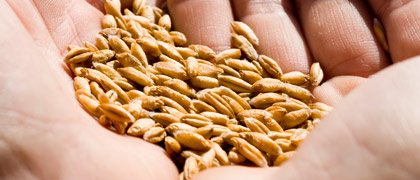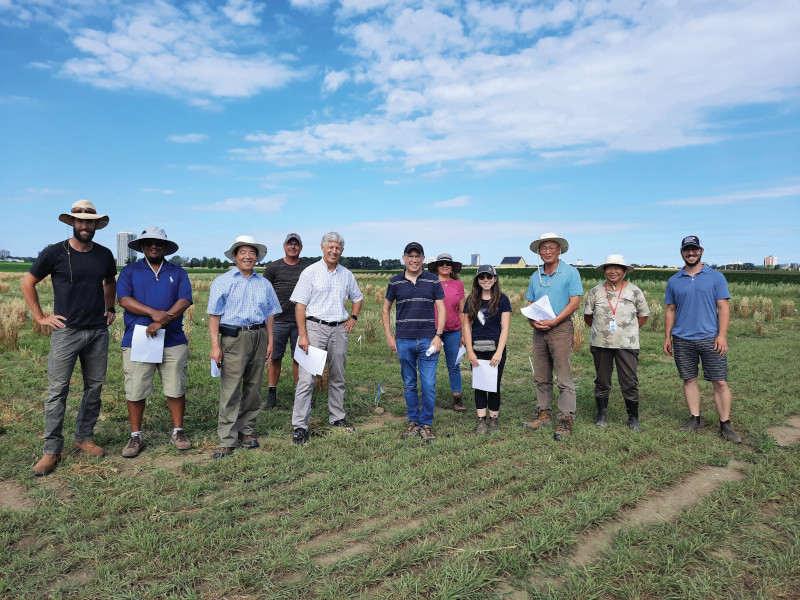
So Much to Choose From
There were record numbers of oilseed and pulse varieties put forward at this year’s Prairie Grain Development Committee annual meeting, signaling exciting times for the industry.
There’s a lot going on in the grain variety development industry, and nowhere was that more evident than the Prairie Grain Development Committee annual meeting in Winnipeg Feb. 24-27.
The annual meeting — held to facilitate the exchange of information relevant to the development of improved cultivars of grain crops for the western Canadian Prairies — was marked this year by a record number of oilseed and pulse crop varieties being submitted by developers for recommendation. The PGDC consists of four independent recommending committees responsible for the testing, evaluation, and recommendation of grain crop candidate cultivars for registration in Western Canada.
“This is one of the highest number of lines we have dealt with,” says Parthiba Balasubramanian, chair of the Pulse and Special Crops Recommending Committee.
The committee looked at 26 lines of new pulse crop varieties, with 22 being supported for registration. The others went unsupported simply because of inadequate data, according to Balasubramanian. “We usually have lines of faba beans and so on, but this year we only had [dry] beans, peas and lentils.”
New varieties recommended for registration included the black (shiny) bean line L09BS520, a high-yielding line adapted to southern Alberta and Saskatchewan. The seed yield of L09BS520 is significantly higher than the check variety AC Black Diamond. The line exhibits a low incidence of common bacterial blight compared to AC Black Diamond. It was developed by Agriculture and Agri-Food Canada in Lethbridge, Alta.
MP1867 is a green cotyledon field pea with significantly better bleaching resistance and green colour intensity than the check varieties CDC Striker and Cooper. MP1867 is similar to the check varieties in reactions to Mycosphaerella blight and fusarium wilt. It was also developed by AAFC in Lethbridge.
World of Wheat
Improving yields was the major focus of the dry bean, pea and lentil lines recommended for registration. At the same time, improved maturity was also a focus, a theme found in the wheat varieties put forward.
“There’s a range of lines that continue to meet the needs of producers in the marketplace, and even niche markets. One of the lines recommended was bred specifically for an organic production system, so that’s pretty unique. We considered five durum lines, two of which were solid-stem and two which were midge-resistant ” says Brian Beres, chair of the Wheat, Rye and Triticale Recommending Committee. In total, the committee unanimously endorsed 17 out of 24 varieties. Most lines recommended this year were wheat, while two were rye and one was a spring triticale.
“There’s another nice [wheat variety] out of the University of Alberta — that’s something that’s caught my attention, in terms of the university being back in the game with the release of CWRS varieties that hit on nice yield potential, but not at the cost of maturity.”
The variety coming out of the U of A program was PT769, a Canada Western Red Spring wheat line adapted to the parkland regions of Western Canada. It’s an early maturing, high-yielding line with very good bunt resistance. “So I think growers in the Peace River region should be pretty excited about what’s coming out of that program. I think it bodes well for farmers and for that program at the University of Alberta,” says Beres.
Just the Flax
Seven lines of flax were put forward, also an unusually high number, according to Oilseeds Recommending Committee chair Daryl Rex. Five of them were recommended for registration. “That’s probably a lot more than we’ve had in awhile,” says Rex.
Developed by the University of Saskatchewan, the yield of FP2385 is significantly higher than the check, CDC Bethune, in the shorter growing season and dark brown, black, grey and dark grey soils of the northern Prairies. Alpha-linolenic acid content is significantly less than the check Flanders. FP2385 lodging resistance is not significantly lower than Flanders.
FP2388 is a flax variety developed by Crop Production Services Canada Inc. In comparison to CDC Bethune, FP2388 yields similarly in the short season zone of Western Canada. In comparison to Flanders, FP2388 has similar days to maturity, lodging resistance, oil content and oil-free protein content. This candidate cultivar also has significantly higher seed size, iodine value and alpha-linolenic acid content when compared to Flanders — the latter quality making it especially suited to use in foods bearing a government-approved health claim stating that flax can help reduce/lower cholesterol.
Health Claims a Factor in Evaluation
Health claims were a topic of discussion and a factor in deciding whether or not some varieties were recommended for registration. Oat variety OT7074 did not receive support from the evaluation team due to high oil content and low beta-glucan levels. Health Canada has approved a health claim saying that oat fibre can help reduce cholesterol — it’s the beta-glucan content that’s believed to do so.
Patricia Juskiw, secretary for the Oat and Barley Committee, says high oil content makes oats unsuitable for milling, and low beta-glucan content can mean it won’t live up to the health claim. However, as far as barley goes, Juskiw adds that HB623 — a hulless two-row food barley line that was recommended for registration — is exciting because barley doesn’t necessarily have to be high in beta-glucan to be recommended for registration as food barley.
“It’s good to know you can just use a normal barley, it doesn’t have to be a high beta-glucan type,” Juskiw says. “High beta-glucan is great if you’re using the barley as a fraction of the baked good, when you’re actually milling it. But for a normal cooking barley, this fits the bill nicely.”
In total, two oat and eight barley lines were recommended for registration.
Not-So-Sweeping Changes
According to Beres, the Wheat, Rye and Triticale Recommending Committee made some changes with regard to voting at the committee level for this year’s meeting. The changes to its operating procedures were made in response to a letter from Agriculture Minister Gerry Ritz received in 2013, calling on the PGDC to streamline its approval process in order to “ensure an approach going forward that encourages innovation and variety development and balances the interests of producers and the entire value chain.”
“The more voting some developers see, they feel there’s a higher probability that the outcome will be less than desirable. So we took that as a fair criticism and implemented a process where, if everything’s endorsed as either ‘do not object’ or ‘support’ among all three of our teams, then there’s no more voting,” Beres says.
“This way it’s unanimously endorsed, there’s no more voting at the committee level, other than a procedural vote to recommend those varieties. We took it one step further at our agronomy evaluation team level, where we don’t even vote at all — we take the information from the request to support that each developer would prepare for a line they’d like to recommended, and we take that data, plug it into a spreadsheet, and we apply value points to that — and the spreadsheet actually determines our decisions without any voting.”
Using this new voting process saved over two hours’ worth of procedural voting at the PGDC meeting held in Winnipeg, he notes, considering the committee looks at such a large number of varieties. But not all committees see a need to make such changes. Juskiw says as far as oats and barley go, committee members don’t see a great need to alter the way their process works.
“We keep changing to meet the requirements of our industry, but then we’re told by government that we need to change again. It’s befuddling to our industry,” she says. “We have people coming from the U.S. and Japan because they know that the registration system in Canada is guaranteeing them a quality product. Why fix something that isn’t broken? We have a very efficient and well-run system. There’s no pushback from our industry that this isn’t working.”
Still, Juskiw says the Oat and Barley Committee is looking at its operating procedures to see where practical changes for oats and barley are in order. One possibility is creating different teams that look at further unique quality aspects of varieties up for recommendation.
Andrea Johnston, director of Agriculture and Agri-Food Canada’s Innovation and Growth Policy Division, spoke at the PGDC meeting in regard to the variety registration process and recent surveys AAFC conducted with both the public and producers about how the process can be improved. According to the results, the majority of respondents — nearly 40 per cent — support allowing the impacts of recent changes to the variety registration system to become more fully evident and then re-assess within the next five years if the system requires more change.
In an online survey, 13 per cent supported total withdrawal of the federal government’s oversight role in variety registration, allowing industry or third parties to assume these functions.
Marc Zienkiewicz
New Canola Varieties Recommended in SaskatoonAt the WCC/RCC annual meeting, held this year in Saskatoon on Feb. 4, several new canola varieties were recommended for registration, displaying a variety of traits including improved yields and disease resistance. According to Raymond Gadoua, canola co-op test manager for the Canola Council of Canada, there were 65 total varieties recommended for registration this year — 47 receiving full recommendation and 18 interim recommendations. “It was a business-as-usual sort of year. We had a slightly lower number of entries, but we’re kind of stabilizing, we used to get more but now we’re at around 60 entries. We used to see 70 to 75 before,” Gadoua says. The new Monsanto TruFlex variety was recommended for interim recommendation. “This is a new glyphosate-resistant technology. That’s one of the newest things we’ve seen, although that technology doesn’t have approval in all major [exporting] markets.” According to Monsanto, two key farmer benefits of TruFlex canola are enhanced weed control and increased flexibility. Farmers will have a broader window of application and greater flexibility to utilize a higher rate of herbicides to provide more effective control of perennial weeds and tough-to-control annual weeds in their canola fields to maximize full yield potential. |











